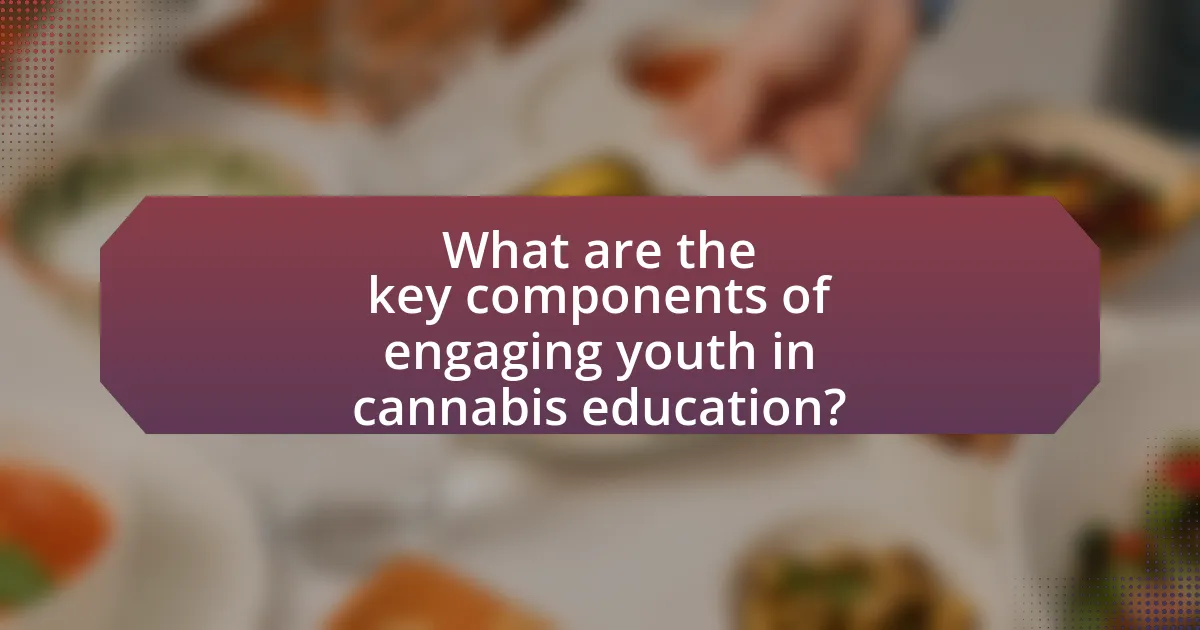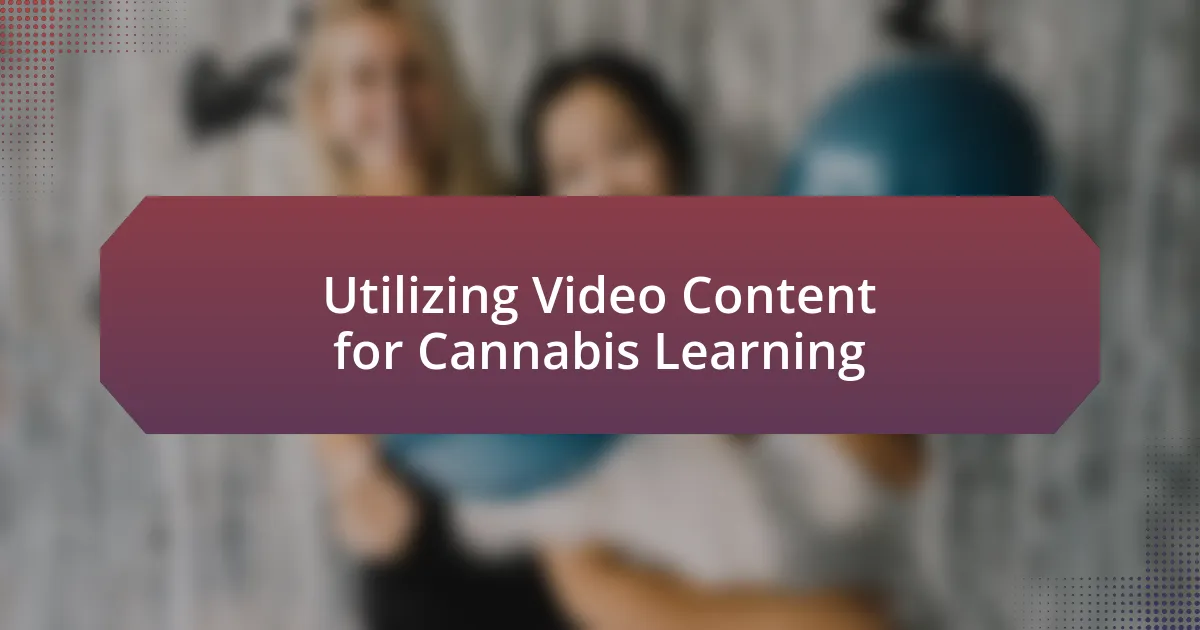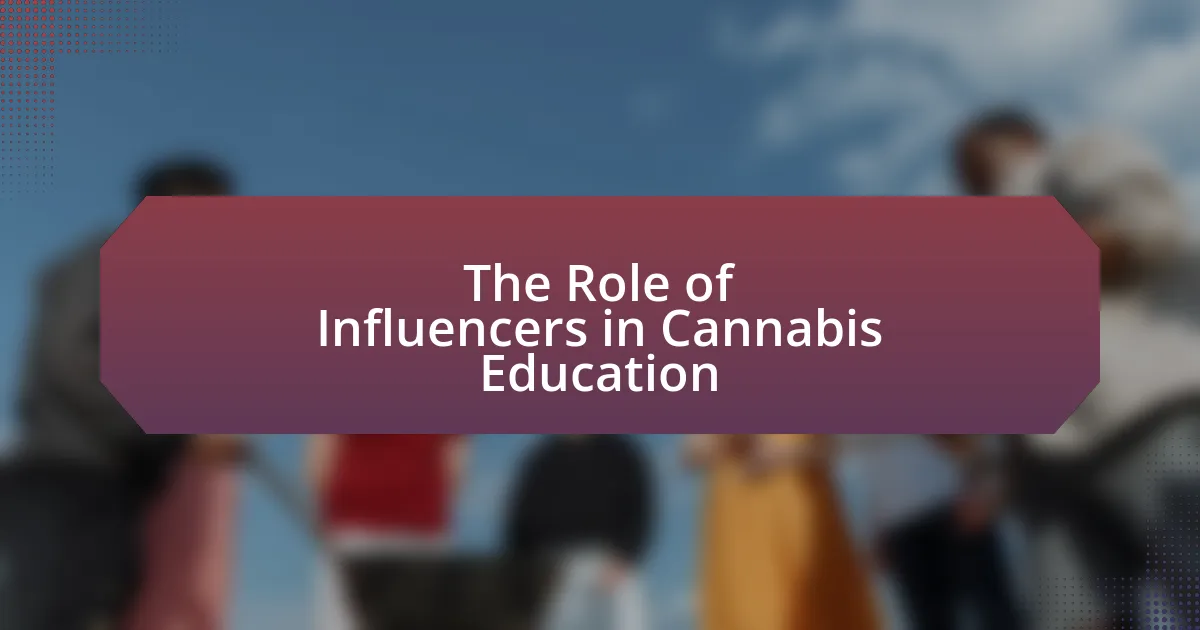The article focuses on engaging youth in cannabis education, highlighting key components such as relevance, interactivity, and accessibility. It discusses how understanding cannabis impacts youth decision-making and addresses common misconceptions that can lead to risky behaviors. The article also explores effective strategies for cannabis education, including the role of peer educators and the importance of culturally relevant materials. Additionally, it examines challenges such as stigma and legal barriers, while emphasizing best practices for implementing educational programs that resonate with young audiences. Overall, the article provides a comprehensive overview of the strategies and challenges involved in educating youth about cannabis.

What are the key components of engaging youth in cannabis education?
The key components of engaging youth in cannabis education include relevance, interactivity, and accessibility. Relevance ensures that the content addresses the interests and concerns of youth, such as health effects and legal implications. Interactivity involves using methods like discussions, workshops, and digital platforms to foster participation and critical thinking. Accessibility means providing information in formats that are easy to understand and available through various channels, including social media and educational apps. Research indicates that programs incorporating these components are more effective in reaching and educating young audiences about cannabis, as they resonate with their experiences and learning preferences.
How does understanding cannabis impact youth decision-making?
Understanding cannabis significantly influences youth decision-making by providing them with accurate information about its effects, risks, and legal status. When youth are educated about cannabis, they are more likely to make informed choices regarding its use, which can lead to reduced experimentation and lower rates of substance abuse. Research indicates that comprehensive cannabis education programs can decrease the likelihood of youth using cannabis by up to 30%, as they are better equipped to weigh the consequences of their actions. This understanding fosters critical thinking and encourages responsible behavior, ultimately shaping healthier lifestyle choices among young individuals.
What are the common misconceptions about cannabis among youth?
Common misconceptions about cannabis among youth include the belief that it is completely harmless, that it does not impair cognitive function, and that it is a gateway drug leading to the use of harder substances. Research indicates that while cannabis may have therapeutic benefits, it can negatively affect brain development in adolescents, leading to long-term cognitive impairments (National Institute on Drug Abuse, 2021). Additionally, studies show that regular cannabis use can increase the likelihood of developing substance use disorders (Volkow et al., 2014). These misconceptions can lead to risky behaviors and a lack of understanding of the potential consequences of cannabis use.
How does cannabis education influence youth perceptions of risk?
Cannabis education significantly influences youth perceptions of risk by providing accurate information about the effects and consequences of cannabis use. Research indicates that comprehensive cannabis education programs can lead to a decrease in the likelihood of youth perceiving cannabis as harmless. For instance, a study published in the Journal of Drug Education found that students who received targeted cannabis education reported a higher awareness of the potential health risks associated with cannabis use, leading to more cautious attitudes towards consumption. This shift in perception is crucial, as it can ultimately affect decision-making and reduce the likelihood of substance use among adolescents.
What strategies can be employed to effectively engage youth in cannabis education?
To effectively engage youth in cannabis education, interactive and relatable educational methods should be employed. Utilizing technology, such as mobile apps and social media platforms, can facilitate access to information in formats that resonate with younger audiences. For instance, research indicates that 70% of youth prefer learning through digital means, highlighting the importance of integrating multimedia content like videos and infographics to convey complex information in an engaging manner. Additionally, incorporating peer-led discussions and workshops can foster a sense of community and encourage open dialogue about cannabis use, its effects, and legal implications. This approach not only enhances understanding but also empowers youth to make informed decisions based on shared experiences and knowledge.
How can interactive learning methods enhance cannabis education for youth?
Interactive learning methods can enhance cannabis education for youth by promoting active engagement and critical thinking. These methods, such as hands-on activities, simulations, and group discussions, allow youth to explore the complexities of cannabis in a safe environment. Research indicates that interactive learning increases retention rates; for instance, a study published in the Journal of Educational Psychology found that students participating in interactive learning scored 20% higher on assessments compared to those receiving traditional instruction. This approach not only fosters a deeper understanding of cannabis-related issues, such as health effects and legal implications, but also encourages informed decision-making among youth.
What role do peer educators play in cannabis education initiatives?
Peer educators play a crucial role in cannabis education initiatives by facilitating knowledge transfer among their peers, which enhances understanding and reduces stigma associated with cannabis use. They leverage their relatability and shared experiences to create a safe environment for open discussions, making the information more accessible and engaging for youth. Research indicates that peer-led programs can lead to increased awareness and informed decision-making regarding cannabis, as evidenced by studies showing that youth are more likely to trust and engage with information presented by their peers rather than authority figures.

What challenges exist in engaging youth in cannabis education?
Engaging youth in cannabis education faces several challenges, including misinformation, stigma, and a lack of tailored content. Misinformation about cannabis can lead to misconceptions that hinder effective education, as many young people may rely on social media or peer opinions rather than scientific facts. Stigma surrounding cannabis use can create reluctance among youth to participate in educational programs, fearing judgment or negative repercussions. Additionally, existing educational materials often do not resonate with younger audiences, lacking relevance or engagement, which diminishes their effectiveness. These factors collectively impede the successful dissemination of accurate cannabis education to youth.
Why is stigma a barrier to effective cannabis education for youth?
Stigma is a barrier to effective cannabis education for youth because it creates an environment of fear and misinformation that hinders open dialogue. When youth perceive cannabis as taboo or associate it with negative stereotypes, they are less likely to seek accurate information or engage in discussions about its effects. Research indicates that stigma can lead to avoidance of educational resources, as young individuals may fear judgment or repercussions from peers and adults. For instance, a study published in the Journal of Adolescent Health found that stigma surrounding cannabis use significantly reduced the likelihood of adolescents discussing cannabis-related topics with trusted adults, thereby limiting their access to factual education.
How does societal perception of cannabis affect youth engagement?
Societal perception of cannabis significantly influences youth engagement by shaping attitudes and behaviors towards its use. When cannabis is viewed positively, youth are more likely to engage in discussions and educational initiatives surrounding it, as seen in regions where legalization has occurred, leading to increased interest in responsible use and harm reduction strategies. Conversely, negative perceptions can deter youth from seeking information or participating in educational programs, as they may fear stigma or legal repercussions. Research indicates that in areas with supportive cannabis policies, youth report higher levels of awareness and understanding of cannabis-related issues, demonstrating that societal attitudes directly impact their willingness to engage in cannabis education.
What are the legal challenges surrounding cannabis education for youth?
The legal challenges surrounding cannabis education for youth primarily involve restrictions on the dissemination of information due to varying state laws regarding cannabis legality. Many states have laws that limit how cannabis can be discussed in educational settings, often prohibiting any promotion or endorsement of its use, even for educational purposes. For instance, in states where cannabis is legal for adults, educational programs may still face scrutiny if they are perceived to encourage use among minors, leading to potential legal repercussions for educators and institutions. Additionally, federal regulations, such as the Controlled Substances Act, classify cannabis as a Schedule I substance, complicating funding and support for educational initiatives aimed at youth. These legal frameworks create a challenging environment for effectively educating young people about cannabis, its risks, and responsible use.
How do cultural differences impact cannabis education strategies?
Cultural differences significantly impact cannabis education strategies by influencing perceptions, beliefs, and communication styles regarding cannabis use. For instance, in cultures where cannabis is stigmatized, educational strategies may need to focus on harm reduction and factual information to counteract negative stereotypes. Conversely, in cultures with a more accepting view of cannabis, education can emphasize responsible use and benefits. Research indicates that tailored approaches, such as incorporating culturally relevant examples and addressing specific community concerns, enhance engagement and effectiveness in cannabis education programs. For example, a study published in the Journal of Drug Issues highlights that culturally adapted interventions lead to higher retention and understanding among diverse youth populations.
What specific cultural considerations should be taken into account?
Specific cultural considerations in engaging youth in cannabis education include understanding diverse cultural attitudes towards cannabis use, recognizing the impact of historical stigmas associated with cannabis in various communities, and acknowledging the role of family and community values in shaping perceptions of cannabis. For instance, in some cultures, cannabis may be viewed negatively due to historical criminalization, while in others, it may be accepted or even integrated into traditional practices. Additionally, tailoring educational content to reflect cultural narratives and using culturally relevant communication methods can enhance engagement and effectiveness. Research indicates that culturally competent approaches in health education improve receptiveness and outcomes, as seen in studies focusing on minority youth and substance use prevention.
How can culturally relevant materials improve engagement?
Culturally relevant materials can improve engagement by making educational content more relatable and meaningful to diverse youth audiences. When materials reflect the cultural backgrounds, experiences, and values of the learners, they foster a sense of belonging and relevance, which enhances motivation and participation. Research indicates that culturally responsive teaching practices lead to higher academic achievement and increased student engagement, as evidenced by a study published in the “Journal of Educational Psychology,” which found that students who learned with culturally relevant materials showed a 20% increase in engagement levels compared to those who did not. This connection between cultural relevance and engagement underscores the importance of tailoring educational resources to meet the needs of varied youth populations, particularly in contexts like cannabis education.

What are the best practices for implementing cannabis education programs for youth?
The best practices for implementing cannabis education programs for youth include using evidence-based curricula, engaging interactive teaching methods, and involving parents and community stakeholders. Evidence-based curricula ensure that the information provided is accurate and reflects current research, such as the National Institute on Drug Abuse’s findings that highlight the risks associated with cannabis use among adolescents. Interactive teaching methods, such as discussions and role-playing, enhance engagement and retention of information, as shown in studies that indicate active participation leads to better learning outcomes. Additionally, involving parents and community stakeholders fosters a supportive environment, which is crucial for reinforcing the messages delivered in educational programs.
How can collaboration with community organizations enhance cannabis education?
Collaboration with community organizations can enhance cannabis education by leveraging local knowledge and resources to create tailored educational programs. These organizations often have established trust within the community, which can facilitate open discussions about cannabis use, its effects, and legal implications. For instance, a study by the National Institute on Drug Abuse highlights that community-based interventions can significantly improve knowledge and attitudes towards substance use among youth. By partnering with schools, health departments, and local advocacy groups, cannabis education can be more effectively disseminated, ensuring that it is relevant and accessible to young people.
What types of partnerships are most effective in reaching youth?
Collaborative partnerships between educational institutions, community organizations, and health agencies are most effective in reaching youth. These partnerships leverage resources, expertise, and networks to create comprehensive educational programs that resonate with young people. For instance, a study by the National Institute on Drug Abuse highlights that programs combining school-based education with community outreach significantly improve knowledge and attitudes toward cannabis use among adolescents. This multifaceted approach ensures that messages are consistent and relevant, ultimately enhancing engagement and understanding among youth.
How can feedback from youth improve cannabis education programs?
Feedback from youth can significantly enhance cannabis education programs by ensuring that the content is relevant, relatable, and engaging for the target audience. Youth perspectives can identify gaps in existing programs, highlight misconceptions, and suggest preferred learning methods, which can lead to more effective educational strategies. For instance, a study by the National Institute on Drug Abuse found that youth are more likely to engage with educational materials that reflect their experiences and concerns, thereby increasing retention and understanding of the information presented. By incorporating youth feedback, programs can be tailored to address specific issues such as peer pressure, social media influence, and the impact of cannabis on mental health, ultimately fostering a more informed and responsible approach to cannabis use among young people.
What resources are available for developing cannabis education initiatives?
Resources available for developing cannabis education initiatives include educational curricula, online training programs, community workshops, and partnerships with health organizations. These resources provide structured information and practical guidance on cannabis use, its effects, and legal considerations. For instance, organizations like the National Organization for the Reform of Marijuana Laws (NORML) offer educational materials and advocacy tools that can be utilized in educational settings. Additionally, the Cannabis Training University provides comprehensive online courses that cover various aspects of cannabis, from cultivation to legal issues, which can be instrumental in shaping effective educational initiatives.
What online platforms provide educational materials for youth?
Online platforms that provide educational materials for youth include Khan Academy, Coursera, and EdX. Khan Academy offers a wide range of free courses covering subjects like math, science, and arts, specifically designed for younger audiences. Coursera partners with universities to provide courses that often include youth-oriented content, while EdX also collaborates with educational institutions to deliver accessible learning resources. These platforms are recognized for their commitment to educational equity and have millions of users globally, demonstrating their effectiveness in reaching youth.
How can educators access training on cannabis education?
Educators can access training on cannabis education through various online platforms, professional development workshops, and educational institutions that offer specialized courses. For instance, organizations like the National Organization for the Reform of Marijuana Laws (NORML) and the Cannabis Training University provide resources and training specifically designed for educators. Additionally, many state education departments have begun to incorporate cannabis education into their professional development programs, reflecting the growing recognition of the need for informed teaching on this subject.
What practical tips can enhance youth engagement in cannabis education?
To enhance youth engagement in cannabis education, interactive and relatable content should be prioritized. Utilizing multimedia resources such as videos, podcasts, and social media platforms can effectively capture the attention of young audiences. Research indicates that 70% of youth prefer learning through visual and auditory means, making these formats particularly effective. Additionally, incorporating peer-led discussions and workshops can foster a sense of community and encourage open dialogue about cannabis use and its implications. Engaging youth in hands-on activities, such as creating educational campaigns or participating in community events, can also increase their investment in the topic.





